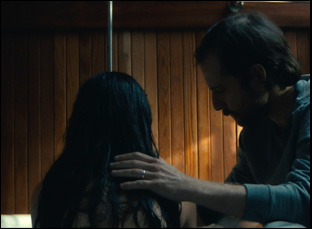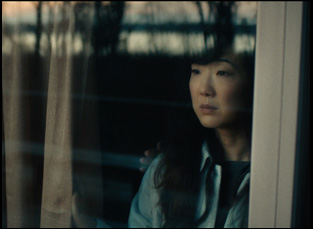Meg (Jennifer Kim) makes clear she isn’t one in need of rescuing at the start of “Somewhere Quiet,” having been through that whole thing before, though you wouldn’t blame the poor truck driver that sees her in the rearview for thinking she’d need a ride seeing her bloodied and bruised in an idyllic coastal community where only the sound of squawking geese threatens the tranquility. Having the driver come out to check on her, it’s easier for Meghan to steal his pickup to make an escape, though in Olivia West Lloyd’s creepy thriller, she can run all she wants and is likely to end up in the exact same place, perhaps thousands of miles away from where she once was abducted, but unable to leave that moment in her mind.
For most, the beginning of “Somewhere Quiet” would be the triumphant end, with Meg appearing to retake control of her destiny, but after all the horror films that Lloyd has obviously seen before, she knows it can’t hardly be that simple and in wondering what happens after, the writer/director makes a most provocative debut as the survivor goes on an excursion with her husband Scott (Kentucky Audley) with the plans to get a little R & R but finding the traumatic equivalent of TNT. It might be ill-advised to take any trip to a cabin in the woods, but that’s just one of the genre tropes that Lloyd toys with as Meg removes herself from a world where people still talk about her well-publicized case yet is plunged into another she doesn’t feel at home in when surrounded by the knickknacks of her husband’s family, a well-to-do family that’s always been at odds with her own upbringing as an adoptee in a modest household. The cabin has obviously seen better days, but the family’s legacy still looms large, particularly when Scott’s cousin Madeleine (Marin Ireland) is back home to take care of her mother at a house nearby, and with Meg unsure about even having her husband around as she decompresses, three’s a crowd.
As unhealthy an environment as it may be for recovery, “Somewhere Quiet” still considers Meg’s mind the most dangerous place to be, growing suspicious of Scott and Madeleine as they start showing an uncomfortable level of affection for one another while playing songs from their youth on the piano together and feels she once again has to be concerned with what’s being put in her food. Whether she’s being cautious or paranoid becomes a captivating question in the chiller where one doesn’t need to see what happened to Meg to know the profound impact it’s had on her, anchored by a strong performance from Kim and how Lloyd and crew go to great lengths to present the warped perspective she’s started to have, from noises that might not have raised an eyebrow before now inciting panic attacks to peculiarities in the decor that lead to troubling thoughts about how they got that way, and while Meg is apt to get stuck on the details, it’s a feat of impressive world-building that adds up to a spooky and unsettling whole.
With “Somewhere Quiet” making noise at its recent premiere at Tribeca, Lloyd spoke about her wonderfully subversive feature debut, knowing just where she should set the seaside thriller because of her own personal experience and finding a unique way to reflect how cycles of violence persist well after any physical act occurs.
I’ve been a horror fan for a long time. I was watching bloody slasher after bloody slasher and I always was struck by these final images of these women covered in blood escaping and then the credits roll and feeling still in the throes of this drama, like I wanted to go with her back to her mom’s house and see what it was like to wash all that blood off and be with her when she went to the grocery store. All of those [routine] things to me felt like something that I really wanted to explore, so that’s where the germ of this idea came from and then got mixed up with all sorts of other ideas, as things do.
It is fascinating to see that image upfront in this and have this circular structure. Did that come to mind pretty quickly?
It definitely did. The intention of starting the film at the end of another film was something that I thought about a lot – like the end plus six months to a year – and it was this idea of “Okay, so we’re starting in this place and then where do we end up? And it did feel like naturally we were going to end up somehow in the same place,” so I toyed with whether it was going to be exactly the same place or whether it was going to be a mirror image or some rhyming ending, but in the end, it felt right for it to recur in that way because a lot of the things that I would talk about with the actors in making this was this idea of the cyclicality of violence and generational trauma, passing it from one person to another as this kind of terrible baton and that when when you ignore it, or try to not look directly at it, all that happens is the recurrence.
One of the ideas I was so taken with was of identity and how Meg was adopted and feeling lost in the culture before she was literally a missing person. How did that come in?
I was interested in this idea of otherness, and I knew that the character of Meg, no matter what her race was going to be othered by this family because they’re so insular and that she was going to always feel like she could not break through. The character of Meg was always Asian American in my mind, but then when Jennifer Kim came on to play her, we really drilled down and gave her a Korean American identity and we talked a lot about American missionaries in Korea and that specific history of Korean adoption in the U.S., and that gave it just one extra beat of otherness that felt right to me.
What sold you on Jennifer? She’s been so great for so many years, but it was really exciting to see her in a lead.
Yeah, she is an incredible actress, and I hope more people cast her as the lead of films because she is exceptional. We did a little audition process for the character of Meg and when we did a reading of a scene and I let Jen go in cold to see where her instincts were. It was almost a perfect read right off the bat and after that, we talked a little bit about the scene and I remember asking her what she thought it was about and her answer was everything I had been thinking about in the writing of the film. It just felt like a perfect match right away and it was pan immediate feeling that this is the Meg.

It was such a delight working with all three of them and they all have very different approaches, and I felt my process as a director was really figuring out how to get out of their way [and find out] what they need and don’t need from me. I do feel like they created this dynamic amongst themselves and the process of seeing how they were interacting and finding ways to making little changes in the moment to allow what their natural instincts were, like okay, if that’s how this relationship is going to feel, then let’s push into that.
The actors brought so much to each of their characters, and it was less whole ideas and more like little mannerisms that they had. Marin has this crazy way of like sticking her tongue out a lot as the character that I thought was so amazing and loved because it was kind of strange but exciting and a little bit provocative, so we leaned into that. These little of these little mannerisms that came out were really fun.
There’s a creepy piano scene that seems particularly dependent on just seeing how the actors engage with one another. Was that fun to shoot?
It was two days in a completely uninsulated shack on the beach, so it was a little intense and quite cold. But it was so fun. It felt like we were doing a play because it was this 12-page scene and I want to say it was 40 set-ups over the course of two days, and those were the moments where those three actors were really able to just sing. They were so epic and it felt like I was trying to keep up with them the whole time. It was just about sort of like catching what they were doing but I remember doing the open blocking for the crew that day and having them run through the whole scene in real time and it was pretty fun.
Was this setting in mind from the start?
It was. I’m from Massachusetts and it was shot in this town called Cotuit, Massachusetts, a very small town in Cape Cod where I have a lot of family and I’ve been going since I was a little kid. It’s a really important place in my memory because it was a site of all of my happiest childhood memories in the summer, biking around with all my cousins and feeling very joyful and welcoming. Then we would always go back for Thanksgiving because my grandparents were there and when you would return, all the leaves were off the trees and the sun was going down at 3 p.m. and no one was there, so it felt like this strange ghost town and it was also the site of these weirdly terrifying Thanksgivings, so I, as a anxious and imaginative child, was obsessed with the idea of maybe there’s somebody in the woods and that I’ll be able to see them because when all the leaves go away, you can see really deep into the trees. That sense of being able to see too far was something that was very evocative to me, so I always felt like it would be a very cinematic place to set a story like this.

Yeah, Caity Birmingham is our brilliant production designer and we had so much fun thinking about what would be in this house. We talked a lot about how this is a house that has passed down through generations so that there would be multiple people who had had hands in decorating it and that gave it this patchwork and dissonant quality. Maybe one grandmother decorated the kitchen, but a totally different person did the bedroom, so it [could have] this weird, funhouse vibe where you enter these different rooms and it’s just this whole other cacophony of wallpaper and little objects. I’m [generally] fascinated by the little objects that people put in their houses because I think they’re so telling.
What’s it like getting the film to Tribeca?
It’s incredible to feel so close now to actually sharing this film because it’s been a long time of being alone with the story and then we let in all these other collaborators — producers, cinematographers, everybody — and now to let in, it feels like we’re opening it up to this whole other thing and the film doesn’t feel complete until people see it, right? So it feels like, okay, finally we get to finish the film in the room all together and the fact that we can do it in New York where so much of our cast and crew is based, it feels fantastic.
“Somewhere Quiet” will screen at Tribeca Festival on June 14th at 5:30 pm at the AMC 19th St. East.





